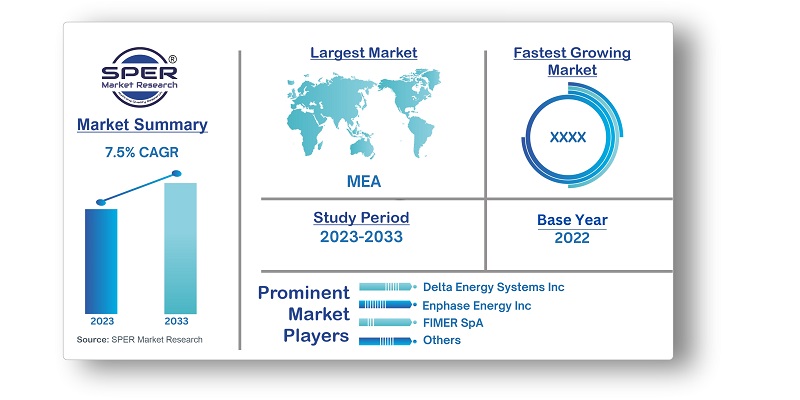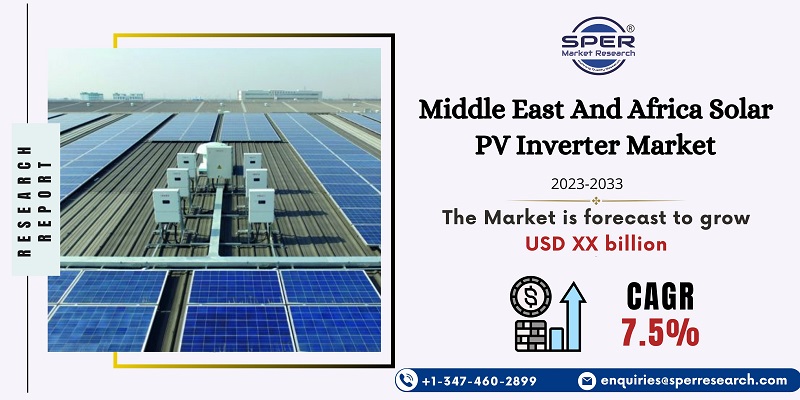
Middle East And Africa Solar PV Inverter Market Growth, Size, Trends, Demand and Future Outlook
Middle East And Africa Solar PV Inverter Market Size- By Inverter Type, By Application- Regional Outlook, Competitive Strategies and Segment Forecast to 2033
| Published: Feb-2024 | Report ID: POAE2416 | Pages: 1 - 152 | Formats*: |
| Category : Power & Energy | |||
- August 2022- There have been reports of the completion of another solar installation in Syria, which had 1,818 solar panels and ten inverters for energy conversion. A one megawatt solar power plant was integrated into the electrical system in the village of Autan.
- January 2022: The Chinese inverter manufacturer Sungrow debuted their brand-new "1+X" central modular inverter, which has an output of 1.1 MW, during the World Future Energy Summit in Abu Dhabi. The 1+X modular inverter can be stacked into eight units to generate 8.8MW of power (ESS). It features a DC/ESS interface for connecting energy storage devices.


| Report Metric | Details |
| Market size available for years | 2019-2033 |
| Base year considered | 2022 |
| Forecast period | 2023-2033 |
| Segments covered | By Inverter Type, By Application |
| Regions covered | Israel, Saudi Arabia, UAE and rest of Middle East and Africa |
| Companies Covered | Delta Energy Systems Inc., Enphase Energy Inc., FIMER SpA, Huawei Technologies Co. Ltd, Mitsubishi Electric Corporation, Omron Corporation, Schneider Electric SE, Siemens AG, Others |
- Solar PV System Installers and Integrators
- Solar PV Component Manufacturers
- Solar PV Project Developers
- Energy Service Companies (ESCOs)
- End Users and Consumers
- Maintenance and Service Providers
- Others
| By Inverter Type: |
|
| By Application: |
|
| By Region: |
|
- Middle East And Africa Solar PV Inverter Market Size (FY’2023-FY’2033)
- Overview of Middle East And Africa Solar PV Inverter Market
- Segmentation of Middle East And Africa Solar PV Inverter Market By Inverter Type (Central Inverters, Micro Inverters, String Inverters)
- Segmentation of Middle East And Africa Solar PV Inverter Market By Application (Residential, Commercial and Industrial, Utility-scale)
- Statistical Snap of Middle East And Africa Solar PV Inverter Market
- Expansion Analysis of Middle East And Africa Solar PV Inverter Market
- Problems and Obstacles in Middle East And Africa Solar PV Inverter Market
- Competitive Landscape in the Middle East And Africa Solar PV Inverter Market
- Impact of COVID-19 and Demonetization on Middle East And Africa Solar PV Inverter Market
- Details on Current Investment in Middle East And Africa Solar PV Inverter Market
- Competitive Analysis of Middle East And Africa Solar PV Inverter Market
- Prominent Players in the Middle East And Africa Solar PV Inverter Market
- SWOT Analysis of Middle East And Africa Solar PV Inverter Market
- Middle East And Africa Solar PV Inverter Market Future Outlook and Projections (FY’2023-FY’2033)
- Recommendations from Analyst
1.1. Scope of the report1.2. Market segment analysis
2.1. Research data source2.1.1. Secondary Data2.1.2. Primary Data2.1.3. SPER’s internal database2.1.4. Premium insight from KOL’s2.2. Market size estimation2.2.1. Top-down and Bottom-up approach2.3. Data triangulation
4.1. Driver, Restraint, Opportunity and Challenges analysis
4.1.1. Drivers4.1.2. Restraints4.1.3. Opportunities
4.1.4. Challenges
4.2. COVID-19 Impacts of the Middle East And Africa Solar PV Inverter Market
5.1. SWOT Analysis5.1.1. Strengths5.1.2. Weaknesses5.1.3. Opportunities5.1.4. Threats5.2. PESTEL Analysis5.2.1. Political Landscape5.2.2. Economic Landscape5.2.3. Social Landscape5.2.4. Technological Landscape5.2.5. Environmental Landscape5.2.6. Legal Landscape5.3. PORTER’s Five Forces5.3.1. Bargaining power of suppliers5.3.2. Bargaining power of buyers5.3.3. Threat of Substitute5.3.4. Threat of new entrant5.3.5. Competitive rivalry5.4. Heat Map Analysis
6.1. Middle East And Africa Solar PV Inverter Market Manufacturing Base Distribution, Sales Area, Product Type6.2. Mergers & Acquisitions, Partnerships, Product Launch, and Collaboration in Middle East And Africa Solar PV Inverter Market
7.1. Middle East And Africa Solar PV Inverter Market Value Share and Forecast, By Inverter Type, 2023-20337.2. Central Inverters7.3. Micro Inverters7.4. String Inverters
8.1. Middle East And Africa Solar PV Inverter Market Value Share and Forecast, By Application, 2023-20338.2. Residential8.3. Commercial and Industrial (C&I)8.4. Utility-scale
9.1. Middle East And Africa Solar PV Inverter Market Size and Market Share
10.1. Middle East And Africa Solar PV Inverter Market Size and Market Share By Inverter Type (2019-2026)10.2. Middle East And Africa Solar PV Inverter Market Size and Market Share By Inverter Type (2027-2033)
11.1. Middle East And Africa Solar PV Inverter Market Size and Market Share By Application (2019-2026)11.2. Middle East And Africa Solar PV Inverter Market Size and Market Share By Application (2027-2033)
12.1. Middle East And Africa Solar PV Inverter Market Size and Market Share By Region (2019-2026)12.2. Middle East And Africa Solar PV Inverter Market Size and Market Share By Region (2027-2033)12.3. Israel12.4. Saudi Arabia12.5. UAE12.6. Rest of Middle East and Africa
13.1. Delta Energy Systems Inc.13.1.1. Company details13.1.2. Financial outlook13.1.3. Product summary13.1.4. Recent developments13.2. Enphase Energy Inc.13.2.1. Company details13.2.2. Financial outlook13.2.3. Product summary13.2.4. Recent developments13.3. FIMER SpA13.3.1. Company details13.3.2. Financial outlook13.3.3. Product summary13.3.4. Recent developments13.4. Huawei Technologies Co. Ltd13.4.1. Company details13.4.2. Financial outlook13.4.3. Product summary13.4.4. Recent developments13.5. Mitsubishi Electric Corporation13.5.1. Company details13.5.2. Financial outlook13.5.3. Product summary13.5.4. Recent developments13.6. Omron Corporation13.6.1. Company details13.6.2. Financial outlook13.6.3. Product summary13.6.4. Recent developments13.7. Schneider Electric SE13.7.1. Company details13.7.2. Financial outlook13.7.3. Product summary13.7.4. Recent developments13.8. Siemens AG13.8.1. Company details13.8.2. Financial outlook13.8.3. Product summary13.8.4. Recent developments13.9. Others
SPER Market Research’s methodology uses great emphasis on primary research to ensure that the market intelligence insights are up to date, reliable and accurate. Primary interviews are done with players involved in each phase of a supply chain to analyze the market forecasting. The secondary research method is used to help you fully understand how the future markets and the spending patterns look likes.
The report is based on in-depth qualitative and quantitative analysis of the Product Market. The quantitative analysis involves the application of various projection and sampling techniques. The qualitative analysis involves primary interviews, surveys, and vendor briefings. The data gathered as a result of these processes are validated through experts opinion. Our research methodology entails an ideal mixture of primary and secondary initiatives.



Frequently Asked Questions About This Report
PLACE AN ORDER
Year End Discount
Sample Report
Pre-Purchase Inquiry
NEED CUSTOMIZATION?
Request CustomizationCALL OR EMAIL US
100% Secure Payment






Related Reports
Our Global Clients
Our data-driven insights have influenced the strategy of 200+ reputed companies across the globe.




















